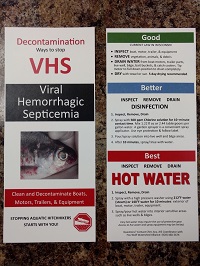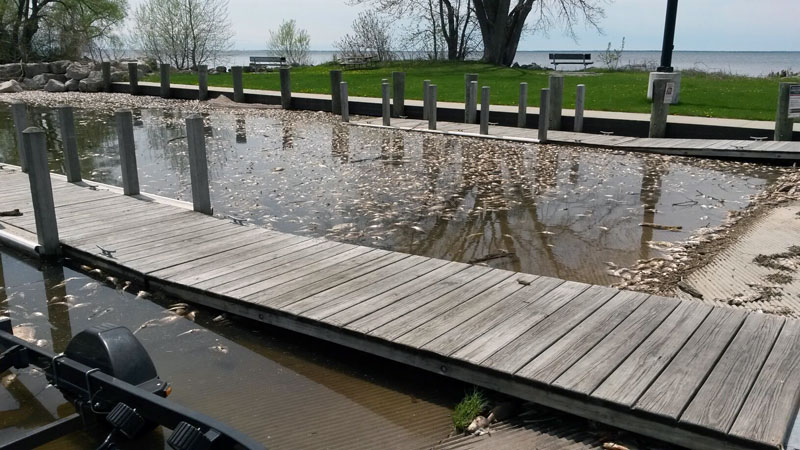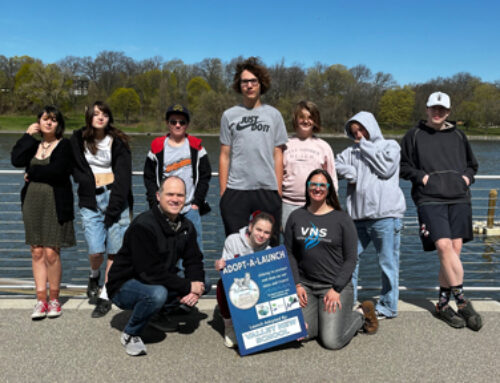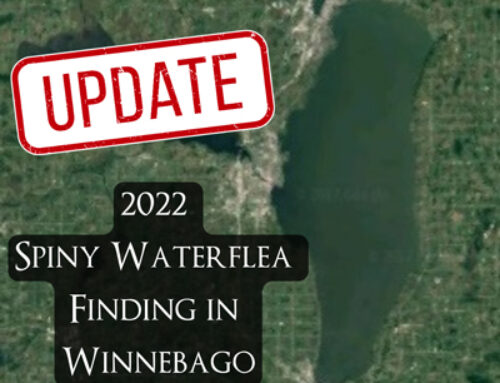Viral Hemorrhagic Septicemia, or VHS, is a deadly fish virus that was confirmed in Lake Winnebago and Little Lake Butte des Morts in May of 2007. It is not native to our waters and is considered an invasive species. The Wisconsin DNR responded on April 24, 2018 to initial reports of large numbers of dead fish, primarily freshwater drum, as well as a few common carp, black crappie, yellow perch, largemouth bass, and bluegill in and around Lake Park in Fond du Lac.
Where did VHS come from?
VHS entered the Great Lakes water bodies, including the Saint Lawrence River, around 2003. The initial 2005 outbreaks killed thousands of fish, including muskies, walleye, lake whitefish, freshwater drum, yellow perch, gizzard shad, redhorse and round gobies. Additionally, Chinook salmon, white bass, emerald shiners, smallmouth bass, bluegill, black crappie, burbot, and northern pike were also affected, but not as severely as the aforementioned species. It is possible that the virus arrived with migrating fish or in ballast water from the Atlantic coast. On the contrary, the WI virus strain is more closely related to the Pacific Northwest strain, so, researchers are not sure where WI’s new strain of VHS has come from.

Fresh-Water Drum. Image from the Freshwater and Marine Image Bank
The virus showed up in the Winnebago system in 2007. More recently, VHS was confirmed in dead bass that were found in Lake De Neveu, which is connected to Lake Winnebago via De Neveu Creek. However, VHS has fortunately not spread to other inland waters. We can prevent further spread of VHS if anglers and other lake users follow some simple precautions, such as draining all water from boats and not transporting live fish or eggs away from state waters. For more details click here.
How does VHS act?
Fish shed the virus into the water via urine and reproductive fluids. Transmission also occurs when fish eat infected dead fish. In severe infections, the virus infects gill tissues before moving into organ tissues and the blood. As the virus progresses, deadly internal hemorrhages in muscle, organ tissue, and skin develop due to weakened blood vessels. Other symptoms of VHS include bulging eyes, unusual behavior, anemia, and bloated abdomens. However, VHS must be confirmed by a lab test because these symptoms appear in other fish diseases.
The infection is most active in water temperatures between 37-54°F and becomes inactive above 59°F. The deadliest water temperatures are between 37-41°F. Because the virus needs cooler temperatures to live, it cannot survive in the bodies of warm blooded organisms. This is why fish-eating birds are not likely to spread VHS and why humans are not affected by it.
Infection does not always lead to death, though. Infected fish can develop antibodies to VHS that will protect it from new infections. However, the concentration of antibodies drops over time, and the fish may start shedding the virus again. The number of fish not exposed to the virus, and hence without any antibodies, increases as time goes by without VHS outbreaks. So, this could lead to a cyclic pattern of large outbreaks. Could this be what we observed in Winnebago?
Stressed fish are more susceptible to infection because stress suppresses immune response. Spawning hormones, poor water quality, lack of food, or excessive handling of fish all induce stress. Improving water quality is one of the ways that we can indirectly reduce the likely hood of a VHS outbreak.
What now?
The DNR is currently doing work with US Fish and Wildlife Service lab in Lacrosse to determine the extent of the Winnebago VHS outbreak. Lab results will tell us which species were killed by VHS and if any other pathogens were present. Their final report should be available sometime in late May or early June.
What can I do?
Everyone can help stop the spread of VHS by following these steps every time they are at a boat launch:
- INSPECT boats, trailers and equipment.
- REMOVE all attached aquatic plants and animals.
- DRAIN all water from boats, vehicles, and equipment, including livewells and buckets containing fish.
- NEVER MOVE plants or live fish away from a waterbody.
- DISPOSE of unwanted bait in the trash
- BUY minnows from a Wisconsin bait dealer. Use leftover minnows only when fishing with them on the same body of water or on other waters as long as no lake or river water or other fish have been added to their container.
Additional steps are provided in the image to the below. Thank you for helping to protect our waterways!
Pro tip: If you want to keep your fish fresh, use ice! Be on the lookout for Clean Boats, Clean Waters boat inspectors on the Winnebago System from June 1st through the 3rd. They will be handing out free ice packs!

More Information
Winnebago Waterways is a Fox-Wolf Watershed Alliance program. The Fox-Wolf Watershed Alliance is an independent nonprofit organization that identifies and advocates effective policies and actions that protect, restore, and sustain water resources in the Fox-Wolf River Basin.
Follow the Fox Wolf Watershed Alliance’s Winnebago Waterways Program on our Winnebago Waterways Facebook page or @WinnWaterways on Twitter! You can also sign-up for email updates at WinnebagoWaterways.org.
This article was written by Austin Pethan for the Winnebago Waterways Program.






